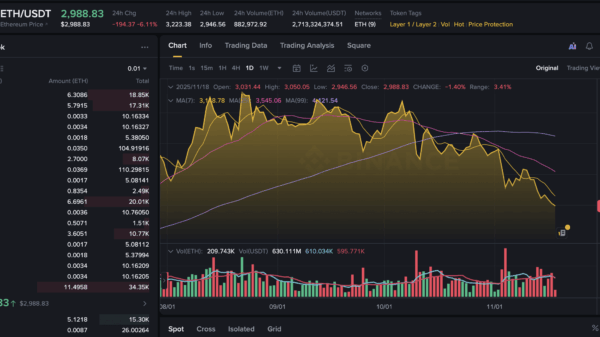Ethereum is experiencing significant downward pressure, currently trading at approximately $3,225 following a sharp decline during U.S. trading hours. This drop comes amid heightened volatility in the broader cryptocurrency market, with ETH registering a 5.5% loss over the past 24 hours and its market capitalization decreasing to $389 billion.
Despite a brief recovery attempt, the overall chart trend remains bearish, driven by liquidity-induced selling and macroeconomic uncertainties that negatively impact market sentiment.
The TradingView chart indicates that Ethereum remained relatively stable early in the session, consolidating within a narrow band before making an attempt to reach the $3,500 mark. However, this effort quickly faltered, leading to a marked downtrend beginning mid-session. A notable spike in selling pressure around 15:00 UTC, characterized by increased red volume, propelled the price sharply from $3,450 down towards $3,250.
This pattern is indicative of forced selling and liquidation pressures rather than standard profit-taking, as evidenced by the rapid acceleration of declines. As the sell-off gained momentum, liquidity diminished, allowing even modest sell volumes to disproportionately affect the price. The volume spikes observed near the daily lows suggest aggressive liquidations were occurring.
The decline in Ethereum”s market capitalization, which fell by more than 5.5% in 24 hours, aligns closely with the downtrend on the chart, reflecting a broader trend of investors exiting large-cap altcoins. Interestingly, the 24-hour trading volume surged by over 41%, indicating that the sell-off was not a result of inactivity or holiday trading but rather a proactive reshuffling of positions.
This increase in trading activity often correlates with various factors, including deleveraging, stop-loss cascades, and high-frequency trading that amplify downtrends. When rising volume coincides with falling prices, it signals a decisive shift towards bearish sentiment in the short term.
From a technical perspective, Ethereum”s chart reveals a breakdown from the previous elevated structure that had maintained its price above $3,400 for a series of sessions. The descent suggests a failed attempt to retest the $3,520 to $3,560 supply zone, resulting in a heavy rejection. Notable technical observations include:
- ETH is now trading beneath its short-term support band, losing the critical buffer zone between $3,350 and $3,300.
- Sellers dominated the latter hours of trading, with ETH hitting its lowest price since early November.
- The weak recovery at the end of the trading session appears to stem from short-covering rather than robust spot buying.
- If ETH cannot reclaim the $3,300 level soon, it may drift toward deeper support levels around $3,150 and $3,050.
The decline in Ethereum”s price parallels a significant drop in Bitcoin, which has also fallen below the $100,000 mark, highlighting the current high correlation within the market. During periods of forced liquidations or macroeconomic sell-offs, altcoins like ETH often experience more severe declines due to their heightened volatility and thinner liquidity.
The current macroeconomic environment remains challenging, with factors such as diminishing expectations for imminent interest rate cuts, weakness in U.S. equities, risk-averse positioning among institutional investors, and decreasing spot ETF inflows continuing to exert pressure on Ethereum”s price. This backdrop persists despite the strong long-term fundamentals associated with Ethereum, including staking growth and ecosystem development.
In the short term, Ethereum”s chart hints at potential stabilization; however, the recent bounce lacks conviction. For ETH to neutralize the immediate downward pressure, it must close confidently above $3,300. Failure to reclaim this level could elevate the likelihood of further declines toward the $3,150 range.
The market structure will only shift bullishly if ETH can consolidate back above $3,400, where previous demand was strongest. Currently, Ethereum”s price trajectory remains closely tied to several factors: Bitcoin”s ability to regain the $100,000 threshold, liquidation activity across major derivatives exchanges, and macroeconomic news as the weekend approaches. If risk appetite returns and Bitcoin stabilizes, Ethereum may be positioned for a swift recovery; otherwise, the market may experience additional downside before buyers re-enter aggressively.






































































